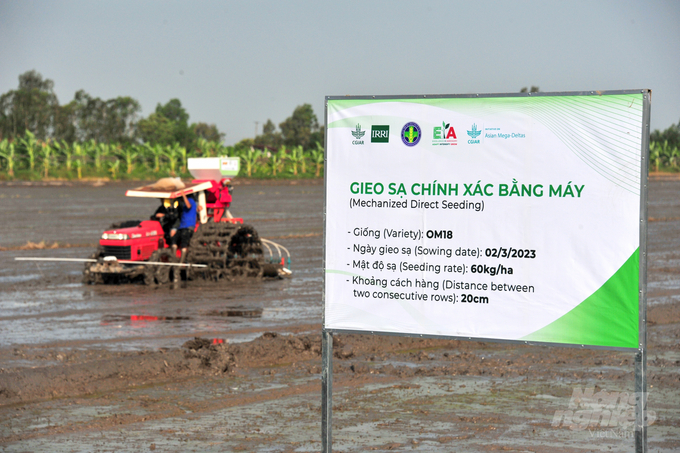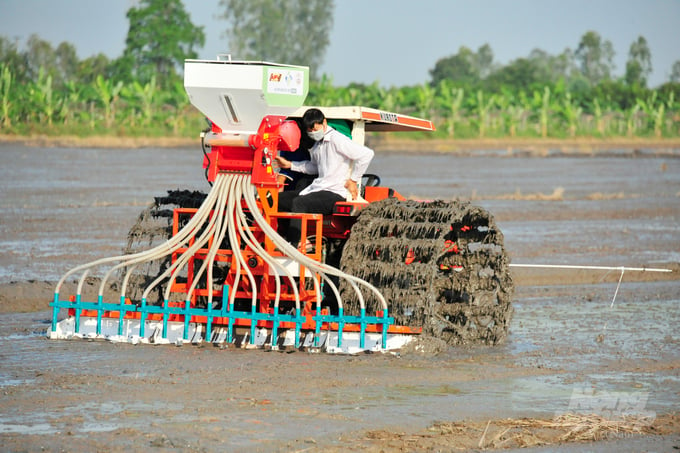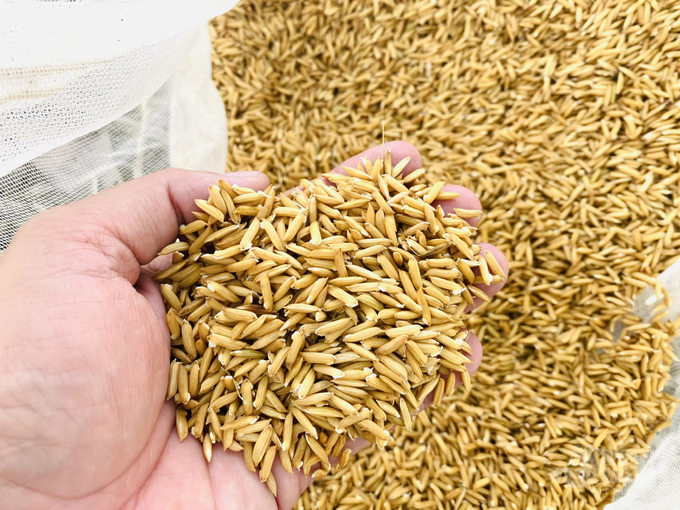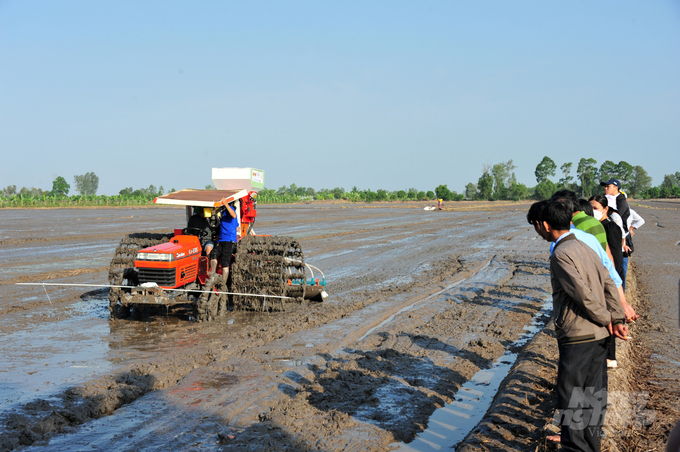
The precise sowing model of the APV machine helps to reduce the seed rate to 60 kg/ha. Picture: Le Hoang Vu.
Precise sowing of APV
The Ministry of Agriculture and Rural Development of Can Tho City, in cooperation with the International Rice Research Institute (IRRI), has just organized a demonstration of precision planting with an APV machine with a seeding rate of 60 kg/ha at a row spacing of 20 cm in summer -Autumn Harvest 2023. On 5 ha of Mr. Vo Hoang Than’s household, in Dong Giang A Hamlet, Dong Binh Township, Thoi Lai District, Can Tho City.
The machine shown to sow in paddy fields is an APV precision seeder researched and tested by IRRI in collaboration with partners (Tien Giang University, Dong Nhan Agricultural Machinery Company and Tu Sang One Member Co., Ltd.). imported machinery and developed technology has been improved to match the Mekong Delta fields. The APV machine can adjust the sowing density and the row spacing and thus flexibly adapt the seed quantity used to the production requirements. The paddy field of the farmers selected for the demonstration has a total area of 5ha, after 3 different sowing treatments for the OM 18 rice variety in the 2023 summer-autumn rice harvest, so that at the end of the season there is a comparison Mechanization aims to reduce seed production and increase economic, social and environmental benefits.
Specifically, 2 ha were sown with an APV machine with a seeding density of 60 kg/ha and a row spacing of 20 cm, 2 ha with a row spacing of 25 cm and the remaining 1 ha with a seed sprayer with a density of 120 kg/ha. Farmers participating in this demonstration model will be supported with the cost of mechanically sowing rice and with a range of input materials, fertilizers sponsored by Binh Dien Fertilizer Joint Stock Company.
This is an IRRI-supported program for the Mekong Delta provinces to promote the use of seed rate reduction mechanization; At the same time, compare the no-till method with APV machines and according to farmers’ practices.
After the winter-spring rice crop of 2022 – 2023 was just harvested, Mr. Vo Hoang Than’s household let the land rest for a week and then hired mechanization to clean the 5-hectare field and for the next summer-autumn -Prepare harvest.
Mr. Vo Hoang Than said that in recent years, rice production has faced many pressures such as high input prices, extreme weather conditions, many pests and diseases, and farmers have had to spend high costs to change the production mentality in rice cultivation by turning rice crops by Mr. Than’s family always brave 100% mechanization in the phases from tillage, sowing to fertilization, spraying by plane, unmanned and harvesting rice with a cutter… both gave good results.

The sowing density is 50-60% rice seeds/ha, which greatly reduces fertilizers and pesticides. Picture: Le Hoang Vu.
“In this year’s summer-autumn rice harvest, I used IRRI’s APV machine to reduce the maximum seeding density to 60kg/ha and the row spacing to just 20cm to reduce seeds, pesticides and pests and reduce harvest risk reduce. I used to sow seeds traditionally at 150-200 kg/ha and even more, now using the APV seeder has reduced the seed rate by more than half, helping to reduce the cost of growing rice by about 40% in comparison the normal way,” said Mr. Than happily.
According to a representative from Tu Sang Co., Ltd. the precision loader uses a controller mounted on a wheeled tractor or plow. For rice cultivation in the Mekong Delta, the machine has been improved to work on wet soil, so the device is mounted on the planter’s tractor. At the same time, the machine has improved some parts of the seeding shaft, rear carriage part, etc., created a drainage hole, and improved the sensor installation position to be suitable for Vietnamese fields. When the Smart Sensor is installed, it sets the operating speed of the machine. Based on the speed of movement on the field surface, the device will automatically notify the controller to coordinate the rotation of the seed to adjust the amount of seed to be sown accordingly. There are cases when the speed of movement of the machine changes due to field conditions, the device records and responds to the control system and immediately automatically adjusts the amount of sowing thanks to the intelligent sensor.
Promote the application of mechanization
Ms. Pham Thi Minh Hieu, Director of Can Tho’s Crop Protection and Cultivation Sub-Department shared: Over the years, the city’s agriculture sector has regularly propagated and encouraged farmers to “decrease 3, increase 3”, “1 correct, 5 correct”. down”. This reduced the sowing density from 200-250 kg/ha to an average of 120-130 kg/ha. In cooperatives, large fields, farmers can sow about 100 kg/ha. In difficult areas, the arable land is fragmented, up to 130 – 140 kg of seeds With the precision planter currently in use, it is possible to significantly reduce the sowing rate to 60 kg/ha, giving farmers many advantages in terms of cost and labor reduction.
Mr. Tran Thai Nghiem, Deputy Director of the Ministry of Agriculture and Rural Development of Can Tho City, said: Low-density sowing is one of the directions for the synchronous application of advanced technical solutions in rice production. The sowing density of 50-60% rice seeds/ha, which leads to a huge reduction in fertilizers and pesticides, should be considered as a solution to help farmers reduce costs and thereby encourage the application of rice varieties. At the same time, the rice meets the quality standards much better than with the traditional method due to the lower use of fertilizers and medicines. In addition to the solutions of low-density sowing, the collection of rice straw in the field is conveniently treated to help improve the environment in climate change adaptation and reduce greenhouse gas emissions.

Sowing 60 kg/ha of rice seeds reduces costs by 40% in summer-autumn harvest. Picture: Le Hoang Vu.
According to Nghiem, in the coming period, the local agricultural sector will accompany the Ministry of Agriculture and Rural Development to implement synchronous strategies to promote the application of mechanization in rice production in particular and in the agricultural sector in general. Besides, it also cooperates with centers, institutes, schools and companies to produce more modern and suitable machines for the area in Can Tho city.
With the prospect of being “supporters” of APV seeders to help farmers reduce the amount of sowing to the lowest level, IRRI Vietnam Office head Ms. Dinh Thi Kim Dung said rice production in Vietnam in the south, especially in the Mekong Delta, has problems with labor shortages, especially in sowing and harvesting. In addition, the cultivation methods are inaccurate, since an excess of sown varieties of rice is used, the density of seedlings is high and uneven, it requires a lot of fertilizer, there is a high risk of disease, and it is easy to fall off when ripe rice is to be harvested, resulting in high harvest and post-harvest losses.

Farmers visit the model of sowing 60 kg/ha rice with IRRI’s APV machine. Picture: Le Hoang Vu.
Therefore, mechanization of precision sowing is essential to reduce seed, fertilizer and pesticide use, reduce post-harvest losses and increase rice quality. Recent studies by the International Rice Research Institute and its partners have shown that mechanization of precision planting can increase rice income by more than 20% and reduce carbon emissions by at least 10% through reduced agricultural input use and post-harvest losses.
In addition, the mechanization of precision sowing enables sustainable and low-emission rice production, value creation from high-quality rice products and future trading in CO2 certificates.
Ms. Dung stressed that the participation of the International Rice Research Institute in this event is one of the important activities to promote the imitation of mechanized precision planting for sustainable rice production in the Mekong Delta. Although initially faced with many difficulties, IRRI believes that this technology will be a breakthrough in the near future.

